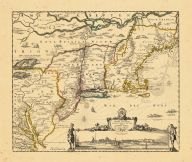NOVI BELGII NOVAEQUE ANGLIAE/PARTIS VIRGINIA
VISSCHER, NICOLAS / SCHENK, P. Jr., 1729-
Image Quality:
 High
High
Jansson : Visscher Map of New England
During the seventeenth century, the Dutch produced both accurate and decorative maps that exemplified the Golden Age of cartography as demonstrated by the Jansson : Visscher series of maps depicting New England. While Jan Jansson's 1651 map entitled "Novi Belgii" is considered to be the first in the series, inaccuracies in the map led Claes Visscher to publish an updated map of the same title around 1655. The maps within the series (approximately twenty-eight in all) span over a hundred years, beginning with William Blaeu's 1635 map of "Nova Belgica" and continuing through the eighteenth century with Conrad Tobias Lotter's version of the map (circa 1760). During this period the map was updated approximately twenty-eight times though many of the major details and the overall design stayed the same. For instance, by comparing the first state (circa 1651) to later states, one can see the changes that occurred when New Sweden fell to the Dutch and when New Amsterdam fell to the English. These changes are evident in the place names and in the additions of new communities as Europeans settled them.
The Visschers were a prominent Dutch map making family, well known in art and cartographic circles, spanning three generations (from 1587 to 1726). Claes Visscher (1587 to 1657) passed the business on to his son Nicolaes (1618 to 1679) who in turn passed it on to his own son, Nicolaes II (1649 to 1702). Even after the death of Nicolaes II's widow (1726), who had carried on the family business after her husband's death, the copper plates continued to be used by other cartographers into the early nineteenth century.
The map, fully entitled "Novi Belgii Novaeque Angliae Nec Non Partis Virginiae Tabula", included present day New England as well as New Jersey, New York, and Maryland and combines both Dutch and Indian place names. Scattered throughout the map are depictions of native flora and fauna: herons, beavers, wild turkeys, deer, rabbits, bears, muskrats, foxes, and wolves. Stockaded settlements and dugout canoes represent the Indian presence. At the bottom of the map is a striking inset view of New Amsterdam showing period houses, ships in the harbor, a windmill, and even a gallows! To either side of the inset are two female Indian figures, allegorical representations of America.
It has been suggested that this engraving is based on a 1648 sketch of New Amsterdam that was thought to be lost. Indeed the two show striking similarities, however, the engraving is often referred to as the "Visscher View" because it was supposed to have appeared for the first time as the inset to Visscher's map. This map truly represents the Dutch superiority in map making during this era, detailed and accurate, yet highly decorative as well.
During the seventeenth century, the Dutch produced both accurate and decorative maps that exemplified the Golden Age of cartography as demonstrated by the Jansson : Visscher series of maps depicting New England. While Jan Jansson's 1651 map entitled "Novi Belgii" is considered to be the first in the series, inaccuracies in the map led Claes Visscher to publish an updated map of the same title around 1655. The maps within the series (approximately twenty-eight in all) span over a hundred years, beginning with William Blaeu's 1635 map of "Nova Belgica" and continuing through the eighteenth century with Conrad Tobias Lotter's version of the map (circa 1760). During this period the map was updated approximately twenty-eight times though many of the major details and the overall design stayed the same. For instance, by comparing the first state (circa 1651) to later states, one can see the changes that occurred when New Sweden fell to the Dutch and when New Amsterdam fell to the English. These changes are evident in the place names and in the additions of new communities as Europeans settled them.
The Visschers were a prominent Dutch map making family, well known in art and cartographic circles, spanning three generations (from 1587 to 1726). Claes Visscher (1587 to 1657) passed the business on to his son Nicolaes (1618 to 1679) who in turn passed it on to his own son, Nicolaes II (1649 to 1702). Even after the death of Nicolaes II's widow (1726), who had carried on the family business after her husband's death, the copper plates continued to be used by other cartographers into the early nineteenth century.
The map, fully entitled "Novi Belgii Novaeque Angliae Nec Non Partis Virginiae Tabula", included present day New England as well as New Jersey, New York, and Maryland and combines both Dutch and Indian place names. Scattered throughout the map are depictions of native flora and fauna: herons, beavers, wild turkeys, deer, rabbits, bears, muskrats, foxes, and wolves. Stockaded settlements and dugout canoes represent the Indian presence. At the bottom of the map is a striking inset view of New Amsterdam showing period houses, ships in the harbor, a windmill, and even a gallows! To either side of the inset are two female Indian figures, allegorical representations of America.
It has been suggested that this engraving is based on a 1648 sketch of New Amsterdam that was thought to be lost. Indeed the two show striking similarities, however, the engraving is often referred to as the "Visscher View" because it was supposed to have appeared for the first time as the inset to Visscher's map. This map truly represents the Dutch superiority in map making during this era, detailed and accurate, yet highly decorative as well.
 Indicates a map that is georeferenced
Indicates a map that is georeferencedThese antique maps and atlases are part of the Historic Map Works, Residential Genealogy™ historical map collection, the largest digital collection of rare, ancient, old, historical, cadastral and antiquarian maps of its type. Read about the collection. Browse entire collection.


